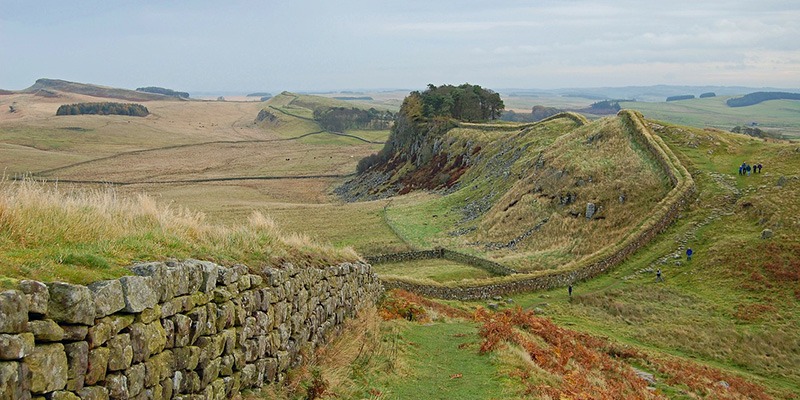Discover the three National Trails that lead through the beautiful landscapes of North West England.
Hadrian’s Wall Path
Hadrian’s Wall Path follows the length of its namesake, the ancient wall built across the north of England in the 2nd century by the Roman emperor Hadrian. As you walk this trail you’ll pass the sections of the wall that still stand and a number of excavated forts that once defended it, all the while experiencing a sense of life as it once was on the wild northern frontier of the Roman Empire. Other highlights include spectacular bridges over the Tyne, the towering rock formations of the Great Whin Sill and the salt marshes of Solway.
This is the only English National Trail that spans the width of the country coast-to-coast. Travelling from west to east, the route begins at Bowness-on-Solway in Cumbria and ends in Wallsend, Newcastle upon Tyne. West to east is the recommended direction to walk the trail as this way you’re more likely to encounter better weather. But travelling from east to west – the direction in which the wall was built – is just as enjoyable. If you have a reasonable level of fitness, you should have no difficulty walking any section of Hadrian’s Wall Path. You’ll find clear signposting from start to finish.
Pennine Way
The Pennine Way is the oldest and most iconic of England’s National Trails. Since 1965, it has lead walkers up and along the mountainous heartlands of Northern England, over Hadrian’s Wall, through the Cheviot Hills and into the Scottish Borders. Along the way, it passes through three National Parks and some of England’s remotest areas of wilderness.
The route begins in the Derbyshire Peak District. There you’ll climb Kinder Scout – a National Nature Reserve and the highest peak in the East Midlands. The next National Park you’ll enter is the Yorkshire Dales where you’ll wind your way through the wildflower meadows and past the waterfalls of Swaledale Valley. The path then continues north under the sparkling night skies of Northumberland National Park. The final section of the Trail leads through the rolling hills of the Scottish Borders, where it reaches its end at the historic village of Kirk Yetholm.
The Pennine Way is a challenging walk. The path is often remote and its quality varies from smooth paving to rough, boggy trackway. Expect lots of hills – the total combined ascent along this trail is greater than the height of Mount Everest. The challenges, however, are all part of the adventure and only add to the satisfaction you’ll feel as you encounter the many magnificent rewards that line the way.
The Trail can be walked year-round but be prepared for snow in the upland sections during winter. For the best chances of fair weather, plan your walk for between mid-May and September. A reliable waterproof and a few changes of dry socks are recommended luggage at all times of the year.
England Coast Path, North West
When complete, the England Coast Path will stretch around the entire English coast, and when it does, it will be the longest coastal walking trail in the world. But at present, only certain sections are open to the public. The first of the two sections that are currently walkable in the North West leads from Allonby to Whitehaven. The other traces the edge of Walney Island.
Allonby is a scenic coastal village of Victorian buildings and cobblestone lanes in the Solway Coast Area of Outstanding Natural Beauty. It’s famous for its long sandy beach and sweeping views that stretch up to the mountains of southern Scotland. Whitehaven is a Georgian town that lies further down the Lancashire coast. Highlights include its historic harbour and The Rum Story - a museum in a former rum shop and warehouse dating from 1785 that tells the story of the rum trade in Britain.
Walney Island, which lies just off Cumbria’s south coast, is a haven for beachgoers and wildlife lovers. Its northern and southern tips are protected nature reserves in which dunes, salt marshes, brackish ponds, shingle and the surrounding waters provide habitats for rare wildlife including porpoises, roe deer, natterjack toads and the Walney Geranium – a flower only found on the island. Walney is also famed for its long sandy beaches and the beauty of its sunsets.
Where to Stay in North West England
There's a great selection of parks close to Hadrian’s Wall Path in Cumbria, Northumberland and Tyne and Wear.
You could own a holiday home on this tranquil park in the Yorkshire Dales near the Pennine Way, or on this park, where you can also go glamping or holiday in your tourer.
Find thousands more campsites and holiday parks across the north west of England.








